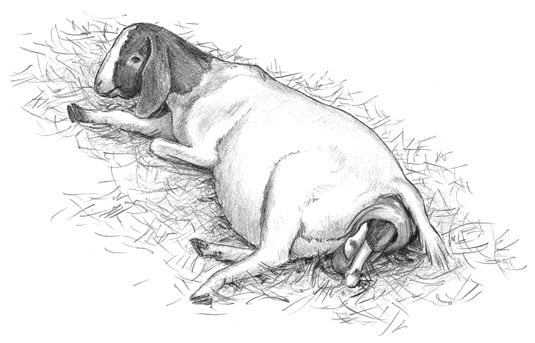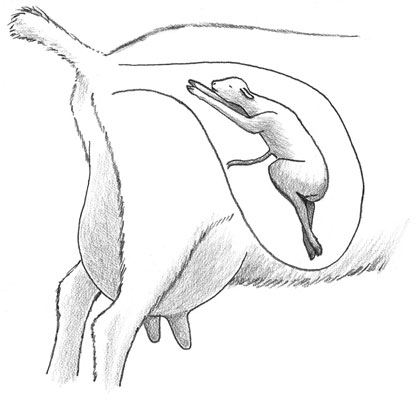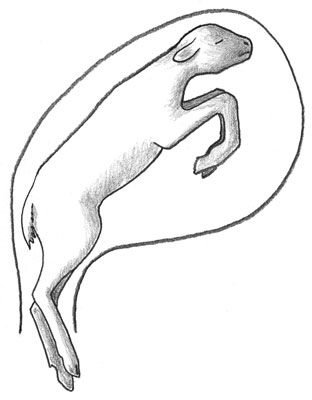The first stage of labor
The uterus contracts and dilates, forcing the unborn kid against the cervix (neck of the uterus). This process usually lasts about 12 hours for goats that are kidding for the first time, but every goat is different.During this stage the goat will be restless. She may look at her side, like she can't figure out what is going on. She may lick herself, or even you. Most goats want to be left alone during this time, and their labor may even slow down or stop if people are around.
 Some goats stand up to deliver their kid, and others lie down.
Some goats stand up to deliver their kid, and others lie down.The second stage of labor
This is when the doe pushes the babies out of her uterus. Her contractions get stronger and if the kid is lined up correctly, it will start moving down the birth canal.From the time the goat starts pushing until the first kid is delivered should be only 30 minutes. If it takes longer than this, the kid may be malpositioned or the doe may have another problem. Investigate whether the kid is stuck or coming out wrong to determine whether you or a vet need to intervene.
You will see thicker discharge, sometimes tinged with blood, and then a bubble at the opening of the vagina. This is the amniotic membrane. If you look in the bubble you usually see a nose and one or two little hooves.
 In a normal birth presentation, the goat is positioned head first, with its hooves outstretched.
In a normal birth presentation, the goat is positioned head first, with its hooves outstretched.Birth problems
Breech presentation (back feet first) is fairly normal in goats. If kids are small, even a frank breech presentation (tail first) doesn't present a problem. The risk in a breech birth is the possibility of inhaling amniotic fluid. A gentle, steady pull on the hind legs in a breech birth will help to ensure that the kid's head comes out promptly. The kid's back feet are positioned first in a breech birth presentation.
The kid's back feet are positioned first in a breech birth presentation.-
Wrap a towel around the kid (the process can be messy).
-
Hold the kid by the feet with one hand and in the area between the head and neck with the other hand.
-
Swing it back and forth several times with head facing out to clear the lungs.
Make sure you are in an area where you won't hit anything and be aware that the kid is slippery.
-
Check the kid's breathing and repeat the process if it isn't breathing.
Other positions that require assistance and can be difficult to reposition include transverse (across the uterus with a side near the cervix), head back (hooves out but head back, usually to one side), or even crown presentation (the top of the head coming first). If you encounter a kid in the wrong position, call a veterinarian or an experienced goat owner to assist you or talk you through it. If you are unable to get the kid into the correct position, you need to have a veterinarian perform a cesarean.

